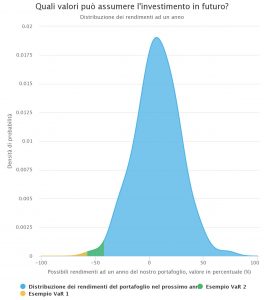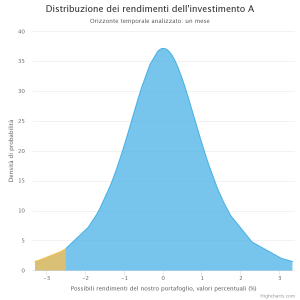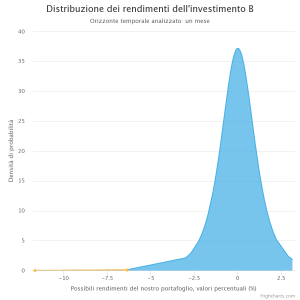One of the best ways basic to read the risk of investments consists in using volatility, as we have said in the last episode. But, as often happens when dealing with complex topics, volatility alone is not enough to give a complete overview of all risk. It is for this reason that we use other risk indicators, such as the VaR (Value at Risk). And no, the slow motion on the pitch has nothing to do with it.
The VaR, in digestible tablets
Let's start with the basics: the goal of VaR is to give an idea of the risk of incurring serious losses in the future. Simple, isn't it?
The VaR takes into consideration those risks which materialize with low probability and which potentially have a heavy impact on the investment. But let's try to be concrete and ask for help from statistics. Let's imagine that we have a crystal ball and that we know the future values that our investment will be able to assume, i.e. its probability distribution. Represented with a graph it should look something like this:

The graph therefore shows us what the 1-year performance of our investment could be: it is a range of possible returns, each with its own probability (indicated with the different heights of the curve).
In this example, our investment is centered on a value of 4-5% per annum: we expect the return to be very likely to be close to those values. But each investment can also take on extreme values (whether positive or negative), and it is precisely these extreme events that are taken into consideration by the VaR.
We are particularly interested and concerned about extreme losses (on the left side of the distribution). Imagine that you "cut" the distribution at some point in the left side (which matches the start of the yellow area or the green area), so those are two examples of VaR. The "cut" will depend on the level of VaR that we have set. But let's proceed slowly, one concept at a time.
How do you read the VaR?
To get an idea of the maximum losses that could be incurred, two important aspects must be established, which together represent the key to understanding the VaR:
- the time horizon, the time frame for which we want to calculate the potential loss;
- the level of probability i.e. the probability that a loss worse than that indicated by the VaR will occur.
VaR is usually expressed as a negative percentage number, even if some prefer to consider its absolute value. So, let's imagine that the monthly VaR 5% of our investment is equal to -9,80%, what does this mean?
The answer is: in the next month it is possible – but very difficult – that our investment will lose more than 9,80%.
Well, but how much difficult? This information is provided by the VaR level, which in our case was set at 5%. We can therefore say that we expect our investment to have a return worse than -9,80% in only 5% of cases.
VaR and Volatility: what are the differences?
While they are both indicators of risk and are often placed side by side, VaR and volatility serve to highlight different things:
- Volatility is a more generic measure of risk, while VaR measures the risk of significant losses. In the example in the next paragraph we will see that two investments with similar volatility can have completely different overall risk.
- Volatility is a measure of dispersion of returns (which can be both positive and negative); on the contrary, VaR focuses only on losses;
- Volatility can be useful both when it is calculated on the past (historical volatility) and on the future (expected volatility); on the contrary, the VaR is normally calculated for the future.
- VaR can be calculated both in percentage and absolute terms. This means that it can also be expressed in monetary value, for example -980€ for an investment of 10.000€); volatility, on the other hand, is always a percentage value.
VaR and Volatility: when to be careful?
Suppose we have two investments and we know their volatility. For simplicity, let's assume that the volatility of the two investments is very similar. The question is: is the risk of the two investments also the same?


In the first case the distribution has a short tail; this means that the risk of maximum loss is contained. Investment B, on the other hand, has a very long left tail. Well, that's not a chart error, that's the signal that the risk of serious losses is substantial and the VaR will be heavy. In fact, with the same volatility, the VaR at 5% with a monthly horizon of the first investment is -2,51%, in the second case it is higher than -6%. Quite a difference: a 2% monthly loss compared to a 6% loss.
The example has been built ad-hoc to highlight the fact that volatility, as a single measure of risk, may not be sufficient to evaluate an investment. Academically speaking, even VaR isn't perfect, but it still helps us understand how a portfolio behaves when things go wrong.




